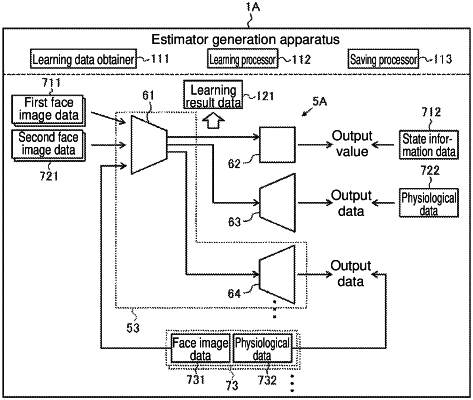| CPC B60W 40/09 (2013.01) [G06N 20/00 (2019.01); G06V 10/764 (2022.01); G06V 10/82 (2022.01); G06V 20/597 (2022.01); G06V 40/174 (2022.01); G06V 40/70 (2022.01); B60W 2040/0872 (2013.01); B60W 2540/22 (2013.01); G06V 40/15 (2022.01)] | 20 Claims |

|
1. An estimator generation apparatus, comprising:
a learning data obtainer configured to
obtain a plurality of first learning datasets each including a combination of first face image data and first state information data, the first face image data including a face of a subject driving a vehicle, the first state information data representing a state of the subject during driving of the vehicle, and
obtain a plurality of second learning datasets each including a combination of second face image data and first physiological data, the second face image data including the face of the subject, the first physiological data being obtained by measuring a physiological parameter about the subject with a sensor; and
a learning processor configured to
construct a first estimator by performing machine learning on the first estimator, the first estimator including an encoder and an estimation unit connected to the encoder to receive an output from the encoder, the first estimator being trained to output, in response to the encoder receiving an input of the first face image data included in a first learning dataset of the plurality of first learning datasets, an output value corresponding to the state of the subject represented by the first state information data associated with the input first face image data from the estimation unit, and
construct a second estimator by performing machine learning on the second estimator, the second estimator including the encoder in the first estimator and a decoder connected to the encoder to receive an output from the encoder, the second estimator being trained to output, in response to the encoder receiving an input of the second face image data included in a second learning dataset of the plurality of second learning datasets, output data reconstructed from the first physiological data associated with the input second face image data from the decoder.
|
|
8. An estimator generation apparatus, comprising:
a learning data obtainer configured to
obtain a plurality of first learning datasets each including a combination of first image data and state information data, the first image data including a subject performing predetermined work, the state information data representing a state of the subject during the predetermined work, and
obtain a plurality of second learning datasets each including a combination of second image data and physiological data, the second image data including the subject, the physiological data being obtained by measuring a physiological parameter about the subject with a sensor; and
a learning processor configured to
construct a first estimator by performing machine learning on the first estimator, the first estimator including an encoder and an estimation unit connected to the encoder to receive an output from the encoder, the first estimator being trained to output, in response to the encoder receiving an input of the first image data included in a first learning dataset of the plurality of first learning datasets, an output value corresponding to the state of the subject represented by the state information data associated with the input first image data from the estimation unit, and
construct a second estimator by performing machine learning on the second estimator, the second estimator including the encoder in the first estimator and a decoder connected to the encoder to receive an output from the encoder, the second estimator being trained to output, in response to the encoder receiving an input of the second image data included in a second learning dataset of the plurality of second learning datasets, output data reconstructed from the physiological data associated with the input second image data from the decoder.
|
|
9. An estimator generation apparatus, comprising:
a learning data obtainer configured to
obtain a plurality of first learning datasets each including a combination of first observation data and state information data, the first observation data being obtained by measuring an activity of a subject performing predetermined work with a first sensor, the state information data representing a state of the subject during the predetermined work, and
obtain a plurality of second learning datasets each including a combination of second observation data and physiological data, the second observation data being obtained by measuring an activity of the subject with the first sensor, the physiological data being obtained by measuring a physiological parameter about the subject with a second sensor different from the first sensor; and
a learning processor configured to
construct a first estimator by performing machine learning on the first estimator, the first estimator including an encoder and an estimation unit connected to the encoder to receive an output from the encoder, the first estimator being trained to output, in response to the encoder receiving an input of the first observation data included in a first learning dataset of the plurality of first learning datasets, an output value corresponding to the state of the subject represented by the state information data associated with the input first observation data from the estimation unit, and
construct a second estimator by performing machine learning on the second estimator, the second estimator including the encoder in the first estimator and a decoder connected to the encoder to receive an output from the encoder, the second estimator being trained to output, in response to the encoder receiving an input of the second observation data included in a second learning dataset of the plurality of second learning datasets, output data reconstructed from the physiological data associated with the input second observation data from the decoder.
|